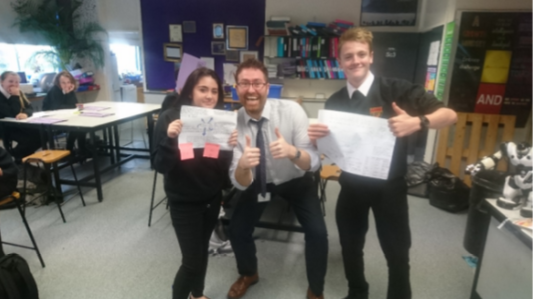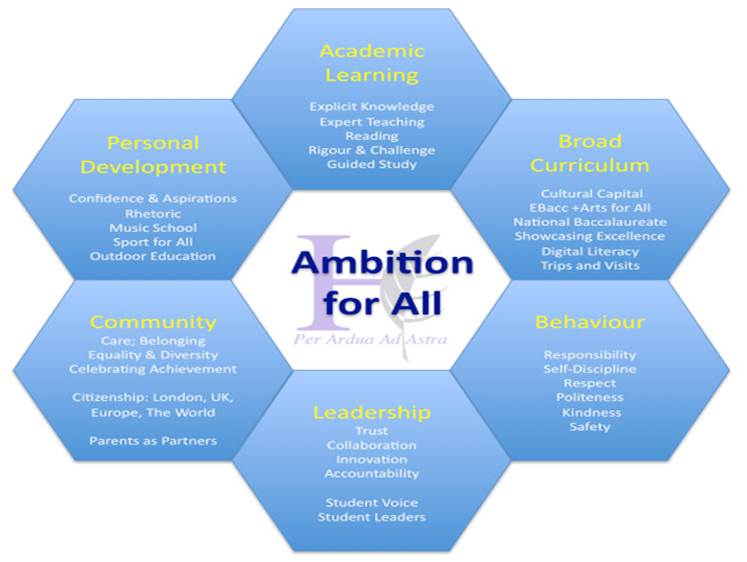– An insight into the Cramlington Model

Our teaching and learning model is our answer to the question — WHAT DOES GREAT LEARNING AT CRAMLINGTON LOOK LIKE?
We believe that great learning happens when clear learning outcomes are combined with engaging learning activities through an understood model of teaching and learning.
The Cramlington model puts fundamental stages of learning in the right order i.e. learning is CONNECTED to prior knowledge. Learning is introduced through the SHARING OF NEW INFORMATION. There is an opportunity for students to develop their understanding through student centred ACTIVITIES and to DEMONSTRATE their new knowledge. Learning is also REVIEWED throughout the lesson.
This learning model and the principles underpinning it are described in this article. Essentially our model is in four parts:
(i) A lesson planning template which puts the important parts of a learning experience in the right order.
(ii) 5 ‘touchstones’ of our pedagogy which are Accelerated Learning, Assessment For Learning, Enquiry, Thinking for learning and ICT to support/enhance learning.
(iii) Developing independent learners through progressively developing learner skills (communication, thinking, collaboration) and learner attributes – the 5R’s (Reasoning, Resourcefulness, Resilience, Responsibility and Reflection).
(iv) Effective teacher behaviours – which describe the type of things teachers do in the classroom to bring lessons to life and to ensure all their students make good progress.
Assessment for Learning
Clarify your learning intention at the planning stage: What’s the purpose of the lesson and how will the students demonstrate their learning to you?
Discuss our learning outcomes: clarify/state what you expect the students to have learnt by the end of the lesson (content), how they will go about learning it (process) and why they are learning it (benefit). Discuss/ share how the students will know how they have been successful and agree the success criteria. Help the students to know and recognize the standards they are aiming for.
Plan in advance the questions you are going to use. Use questions to create new knowledge/learning rather than rehearsing existing knowledge. Show how you expect everyone to be ready to answer questions by using the no hands rule and give students time to respond (think time).
Feedback written or oral should cause thinking:
• Say what he/she has done well
• What the student needs to improve
• How they can improve
• Give the student time to think about your feedback and respond to you thereby creating a dialogue about their learning.
Create shared responsibility for learning through students:
• Assessing each other’s work (e.g. using a rubric)
• Self assessing their work against the agreed success criteria, a rubric or exemplar work you have provided
Adjust your teaching appropriately in light of student responses.
Points to consider:
• Is it an expectation in your classroom that everyone is ready to answer questions? Do you use the no hands rule?
• What do the tasks you set tell you about your students learning?
• Do you amend your teaching plans in light of the feedback you gather in a lesson?
Thinking
Principles
• Teachers plan activities which engage students in higher order thinking
• Students have a vocabulary to discuss and explore their thinking
• Students are explicitly taught how to be better/deeper thinkers
• Students are able to select appropriate thinking tools to help them organize and structure their thinking
The National Thinking skills are defined as the following:
Information-processing skills: These enable students to locate and collect relevant information; to sort, to classify, sequence, compare and contrast; and to analyse part/whole relationships.
Reasoning skills: These enable students to give reasons for opinions and actions, to draw inferences and make deductions, to use precise language to explain what they think, and to make judgements and decisions informed by reasons or evidence.
Enquiry skills: These enable pupils to ask questions, to pose and define problems, to plan what to do and how to research, to predict outcomes and anticipate consequences, and to test conclusions and improve ideas.
Creative thinking skills: These enable students to generate and extend ideas, to suggest hypotheses, to apply imagination, and to look for alternative innovative outcomes.
Evaluation skills: These enable students to evaluate information; to judge the value of what they read, hear and do; to develop criteria for judging the value of their own and others’ work or ideas; and to have confidence in their judgements
Points to consider:
• Do you model thinking out loud in front of your students?
• Do you plan for the use of thinking tools and graphic organizers?
• Do you encourage students to reflect on their thinking (metacognition)?
Accelerated Learning
Principles
• Learning is social
• Learning is active
• Learning is connected to prior learning
• Students know where the learning fits into the wider context (big picture)
• Learning is activated through emotional hooks and engaging questions
• Learning allows for multiple ways of accessing and processing nformation (VAK and multiple intelligences)
• Learning takes place in a positive emotional environment
• Learning takes place in an appropriate physical environment
• Learning happens best when learners are stretched and challenged
• Learning takes place when it is rehearsed and reviewed on a regular basis
Points to consider
• Do you engage students through stories, props, humour and interesting questions
• Do you use a variety of teaching and learning strategies to accommodate students who learn in different ways.
• Do you organize your lessons to allow for students to learn in different ways?
• Do you build meaningful relationships with students and know them well – is your classroom a ‘no put down zone!’.
• Do you make full use of the physical learning environment e.g. questions walls, constextualising display, room layout, keywords etc
Enquiry Based Learning
An Enquiry is based around a question to be answered or a problem to be solved.
Enquiries can be:
• Structured OR Unstructured
• Short OR Extended
• Individual OR Group
For example
‘How can we ensure that everyone on the planet has access to fresh water?’
– Could be the basis for an extended, unstructured, group enquiry with students coming up with their own ideas and solutions.
Whereas
‘Does changing the temperature affect the rate of a chemical reaction?’
– Might be a shorter and more structured enquiry designed to run over a lesson with the teacher asking each student to demonstrate their understanding through a lab report completed as homework.


Characteristics of an Enquiry based classroom
• Learning is based around a question to be answered or a problem to be solved
• Students are encouraged to generate (sub)questions of their own
• Learning can be Messy – doesn’t always go in a “straight line”
• Students are involved in active exploration and research
• Students may have some choice over what, how, and with who they learn
• Students do the thinking-teacher doesn’t do it for them
• Questions can be complex with multiple possible solutions
• Students will get it wrong sometimes
• Teacher is facilitator/resource/ critical friend/architect of the learning experience
• Learning outcomes are focussed
on process as well as content
• Students present their learning to an audience
• Debriefing the “what” has been learned and the “how” did we learn it are absolutely vital
Enquiry based learning becomes Project based learning
• When enquiries are set in real world contexts i.e. real problems to be solved
• With meaningful outcomes i.e. the result of students learning culminates in an outcome that makes a difference in or to the community
• When adults or “experts” other than teachers are consulted or involved.
• And when students present what they have learnt to a real audience
• At Cramlington students are taught a process for “stepping” through an enquiry. This is the
• Enquiry Cycle and its purpose is to give students a way to “scaffold” their journey through an enquiry.
Mark Lovatt


 Hand it out; show the kids what great work looks like.
Hand it out; show the kids what great work looks like.
 Concept check:
Concept check:



























